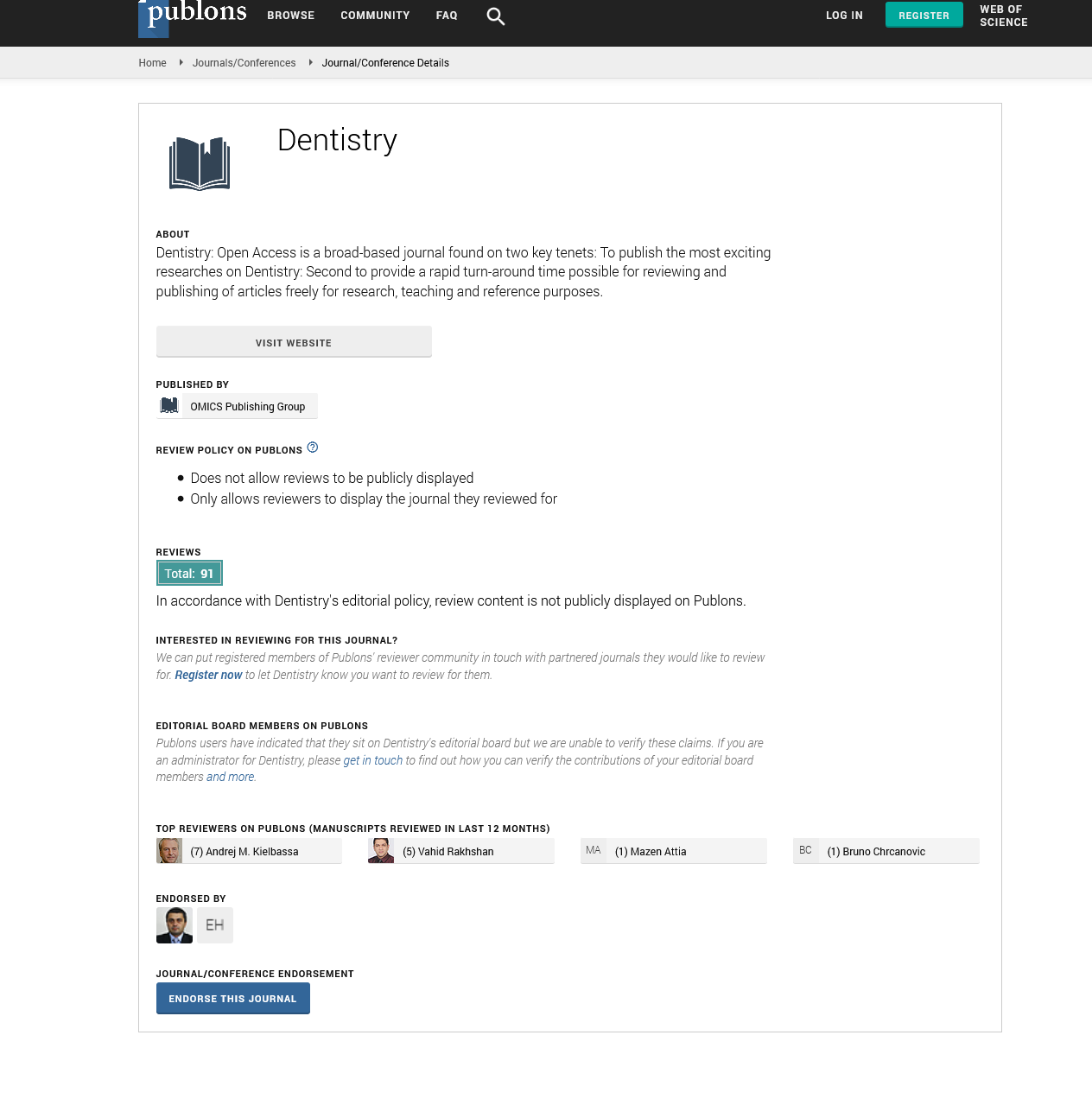Citations : 2345
Dentistry received 2345 citations as per Google Scholar report
Indexed In
- Genamics JournalSeek
- JournalTOCs
- CiteFactor
- Ulrich's Periodicals Directory
- RefSeek
- Hamdard University
- EBSCO A-Z
- Directory of Abstract Indexing for Journals
- OCLC- WorldCat
- Publons
- Geneva Foundation for Medical Education and Research
- Euro Pub
- Google Scholar
Useful Links
Share This Page
Journal Flyer

Open Access Journals
- Agri and Aquaculture
- Biochemistry
- Bioinformatics & Systems Biology
- Business & Management
- Chemistry
- Clinical Sciences
- Engineering
- Food & Nutrition
- General Science
- Genetics & Molecular Biology
- Immunology & Microbiology
- Medical Sciences
- Neuroscience & Psychology
- Nursing & Health Care
- Pharmaceutical Sciences
Perspective - (2025) Volume 15, Issue 1
Postoperative Care and Healing Issues in Apicoectomy Patients
Sune Boschini*Received: 25-Feb-2025, Manuscript No. DCR-25-28558; Editor assigned: 27-Feb-2025, Pre QC No. DCR-25-28558 (PQ); Reviewed: 13-Mar-2025, QC No. DCR-25-28558; Revised: 20-Mar-2025, Manuscript No. DCR-25-28558 (R); Published: 27-Mar-2025, DOI: 10.35248/2329-9088.25.15.722
Description
Apicoectomy, or root-end surgery, is a common endodontic procedure performed when conventional root canal therapy is insufficient in resolving periapical infections. This microsurgical technique involves removing the apical portion of the root, eliminating infected tissue and sealing the root end with a biocompatible material. While generally effective, complications may arise, particularly in maxillary premolars and molars, due to their anatomical complexity and proximity to critical structures. This article examines potential complications following apicoectomy in these teeth and discusses factors that influence treatment outcomes.
Common complications
Sinus perforation: Maxillary premolars and molars are in close proximity to the maxillary sinus, increasing the risk of sinus membrane perforation during apicoectomy. This complication can lead to Oroantral communication, chronic sinusitis, Nasal congestion or discharge
Proper preoperative assessment using Cone-Beam Computed Tomography (CBCT) helps identify the relationship between the roots and the sinus, reducing the risk of this complication.
Postoperative pain and swelling: Pain and swelling are common after apicoectomy, typically peaking within the first 48 hours. These symptoms may result from surgical trauma to surrounding tissues, inflammatory response to bone removal and curettage, Irritation from root-end filling materials
Management involves the use of anti-inflammatory medications, cold compresses and proper post-surgical care. Prolonged pain or swelling may indicate underlying infection or inadequate healing.
Nerve damage: Although less common in the maxilla than in the mandible, nerve injury remains a potential complication, particularly in cases where roots are positioned near the infraorbital nerve. Nerve damage can manifest as Numbness or tingling in the upper lip or adjacent soft tissues, altered sensation that may persist for weeks or months, Minimizing excessive surgical trauma and using magnification tools during surgery help reduce the risk of nerve injury.
Fracture of the root or surrounding bone
During apicoectomy, excessive removal of root structure or aggressive instrumentation may lead to Root fractures, compromising the structural integrity of the tooth, Bone fractures, delaying healing and increasing infection risk Careful execution of root-end resection and preservation of supporting structures improve long-term prognosis.
Soft tissue complications: Inadequate flap design or improper suturing techniques can result in Wound dehiscence, delaying healing and exposing underlying structures, Excessive scar formation, leading to aesthetic concerns, Soft tissue necrosis due to compromised blood supply
Maintaining proper surgical technique, ensuring adequate tissue hydration and using minimally invasive methods contribute to improve healing.
Failure of root-end filling: The success of apicoectomy depends largely on achieving an effective apical seal with biocompatible materials. Root-end filling failures may be caused by inadequate adaptation of filling materials, Leakage along the root-end interface, Incompatibility of the material with periapical tissues
Materials such as Mineral Trioxide Aggregate (MTA) and bioceramic sealers have been shown to enhance sealing ability and biocompatibility, improving long-term success rates.
Factors influencing complication rates
Several factors contribute to the occurrence of complications after apicoectomy in maxillary premolars and molars.
Anatomical considerations: The complex root morphology of maxillary molars, particularly mesiobuccal roots with accessory canals, poses challenges in complete debridement and the proximity of the maxillary sinus increases the risk of sinusrelated complications.
Surgical technique: Proper use of magnification (such as dental operating microscopes) improves precision and microsurgical instruments and ultrasonic tips reduce excessive bone removal, preserving surrounding structures.
Patient factors: Systemic conditions such as diabetes and osteoporosis can impair wound healing and increase infection risk and Smoking has been associated with delayed healing and higher rates of surgical failure.
Postoperative care: Compliance with postoperative instructions, including oral hygiene measures and medication adherence, influences healing outcomes and Regular follow-ups allow early detection and management of potential complications.
Management strategies for complications
Effective management of complications following apicoectomy involves.
Infection control: Antibiotic therapy and proper wound care help resolve postoperative infections.
Management of sinus perforation: Small perforations may heal spontaneously, while larger defects may require closure using a sinus membrane repair technique. .
Pain management: Anti-inflammatory drugs and analgesics provide symptomatic relief. Treatment of nerve injury: Most nerve injuries resolve over time, but persistent cases may require further evaluation by a specialist.
Addressing soft tissue defects: Proper flap repositioning and grafting procedures can aid in soft tissue healing.
Citation: Boschini S (2025). Postoperative Care and Healing Issues in Apicoectomy Patients. J Dentistry. 15:722.
Copyright: © 2025 Boschini S. This is an open-access article distributed under the terms of the Creative Commons Attribution License, which permits unrestricted use, distribution, and reproduction in any medium, provided the original author and source are credited

